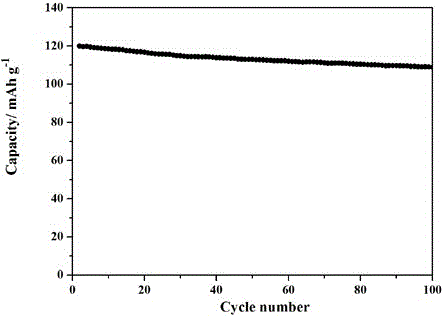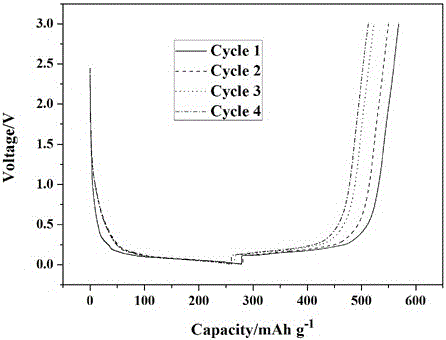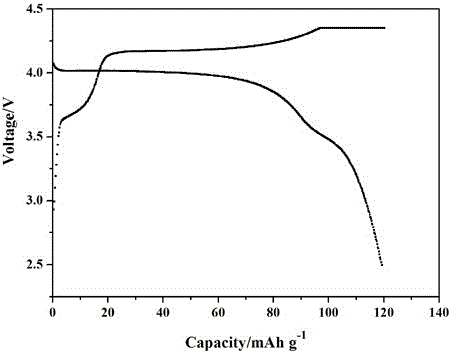Lithium battery electrode preparation method including polymer material with stable interface and application of lithium battery electrode in solid lithium battery
A technology of polymer materials and interface stabilization, which is applied in battery electrodes, lithium batteries, secondary batteries, etc.
- Summary
- Abstract
- Description
- Claims
- Application Information
AI Technical Summary
Problems solved by technology
Method used
Image
Examples
Embodiment 1
[0034] Add AIBN to VCA under argon protection, the mass fraction of AIBN is 0.1%; 40 o C temperature, stirring for 24 hours, to obtain PVCA polymer; PVCA polymer was dissolved in DMF, made into a 2wt.% solution. Preparation of LiFePO for Lithium Batteries Using PVCA Polymer as Binder 4 Electrode pole piece, the mass fraction of binder is 10%; LiFePO 4 The electrode pole piece is immersed in the PVCA solution for 1 minute and then taken out; at 60 o C under vacuum drying for 24 hours to ensure that the solvent has been completely volatilized to obtain PVCA polymer-coated LiFePO 4 Electrode pads.
[0035] The materials used to prepare and assemble lithium-ion batteries are shown in Table 1. The negative pole is uncoated metal lithium, and the solid electrolyte is PVCA / LiDFOB all-solid electrolyte obtained by in-situ polymerization. The first charge specific capacity of the prepared ion battery is 122mAhg -1 , the first discharge specific capacity is 119mAhg -1 , the first C...
Embodiment 2
[0039] Add BPO in the VCA under argon protection, the mass fraction of BPO is 0.5%; 80 o C temperature, stirring for 2 hours, to obtain PVCA polymer; PVCA polymer was dissolved in DMF, made into a 5wt.% solution. Using PVCA polymer as a binder to prepare graphite electrode pole pieces for lithium batteries, the mass fraction of the binder is 5%; the graphite electrode pole piece is immersed in PVCA solution for 5 minutes and then taken out; at 60 o C under vacuum drying for 24 hours to ensure that the solvent has been completely volatilized to obtain a PVCA polymer-coated graphite electrode pole piece.
[0040] The materials used to prepare and assemble lithium-ion batteries are shown in Table 1. The reference electrode is uncoated lithium metal, and the solid electrolyte is PVCA / LiTFSI all-solid electrolyte obtained by in-situ polymerization. The first charge specific capacity of the prepared ion battery is 336mAhg -1 , the first discharge specific capacity is 289mAhg -1 ,...
Embodiment 3
[0044] Add AIBN to VCA under argon protection, the mass fraction of AIBN is 1%; 60 o C temperature, stirring for 12 hours, to obtain PVCA polymer; PVCA polymer was dissolved in DMF, made into a 20wt.% solution. Preparation of LiFe for Lithium Batteries Using PVCA Polymer as Binder 0.2 mn 0.8 PO 4 Electrode pole piece, the mass fraction of binder is 20%; LiFe 0.2 mn 0.8 PO 4 The electrode pole piece is immersed in the PVCA solution for 1 minute and then taken out; at 60 o C under vacuum drying for 24 hours to ensure that the solvent has been completely volatilized to obtain PVCA polymer-coated LiFe 0.2 mn 0.8 PO 4 Electrode pads. Using PVCA polymer as a binder to prepare graphite electrode pole pieces for lithium batteries, the mass fraction of the binder is 5%; the graphite electrode pole piece is immersed in PVCA solution for 2 minutes and then taken out; at 60 o C under vacuum drying for 24 hours to ensure that the solvent has been completely volatilized to obtain ...
PUM
| Property | Measurement | Unit |
|---|---|---|
| thickness | aaaaa | aaaaa |
| quality score | aaaaa | aaaaa |
| quality score | aaaaa | aaaaa |
Abstract
Description
Claims
Application Information
 Login to View More
Login to View More - R&D
- Intellectual Property
- Life Sciences
- Materials
- Tech Scout
- Unparalleled Data Quality
- Higher Quality Content
- 60% Fewer Hallucinations
Browse by: Latest US Patents, China's latest patents, Technical Efficacy Thesaurus, Application Domain, Technology Topic, Popular Technical Reports.
© 2025 PatSnap. All rights reserved.Legal|Privacy policy|Modern Slavery Act Transparency Statement|Sitemap|About US| Contact US: help@patsnap.com



